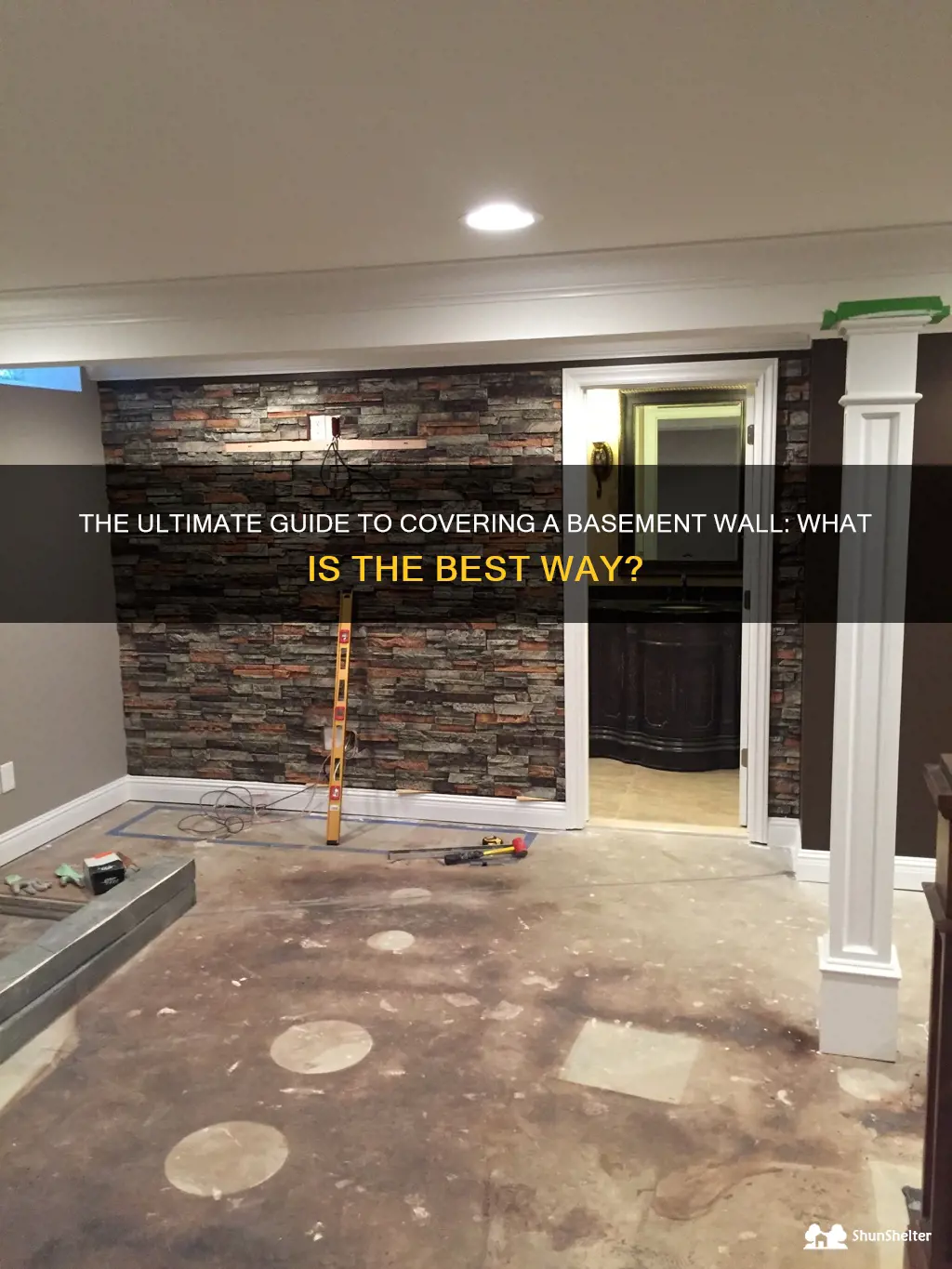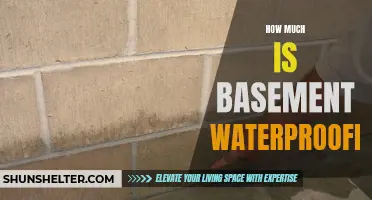
Are you tired of staring at dull and uninspiring basement walls? If so, you're not alone. Many homeowners are on a quest to find the best way to cover their basement walls and transform their space into something more inviting and visually appealing. Whether you're looking to create a cozy home theater, a trendy home gym, or an extra living area for your family, finding the right wall covering is crucial. In this article, we'll explore some of the best methods and materials to cover your basement walls, giving you the inspiration you need to turn your basement into a truly remarkable space.
| Characteristics | Values |
|---|---|
| Durability | High |
| Moisture resistance | Excellent |
| Insulation properties | Good |
| Soundproofing capabilities | Good |
| Fire resistance | Excellent |
| Installation ease | Moderate |
| Cost | Varies (based on material) |
| Maintenance | Low |
| Aesthetics | Varies (based on material) |
| Availability | Easy to find |
What You'll Learn

Types of materials used for covering basement walls

Basement walls are often left unfinished, leaving the concrete exposed. While this may be functional, it can also create a cold and dreary atmosphere in your basement. To create a warm and inviting space, covering the basement walls is highly recommended. There are several materials you can use to cover your basement walls, each with its own advantages and considerations. In this article, we will explore some of the most common materials used for covering basement walls.
Drywall:
Drywall is a popular choice for covering basement walls due to its cost-effectiveness and ease of installation. It is a lightweight material that can be easily cut to fit your basement walls. Before installing drywall, it is essential to address any moisture issues in the basement, as drywall is susceptible to damage from moisture. It is also recommended to use mold-resistant drywall to prevent the growth of mold and mildew.
Insulated Wall Panels:
Insulated wall panels offer both insulation and a finished look for your basement walls. These panels are typically made of rigid foam insulation with a durable facing material, such as vinyl or aluminum. Insulated wall panels offer excellent energy efficiency, helping to regulate the temperature in your basement. They are also moisture-resistant, making them a suitable choice for basements prone to moisture issues. However, insulated wall panels tend to be more expensive than other options.
Plywood:
Plywood is another viable option for covering basement walls. It is a durable, cost-effective material that is relatively easy to install. Before installing plywood, it is essential to seal the concrete walls and address any moisture issues. Plywood should be treated with a waterproof sealant or paint to prevent moisture damage. Keep in mind that plywood is not as resistant to moisture as other materials, so it may not be the best choice for basements with significant moisture issues.
Cement Board:
Cement board is a highly durable and moisture-resistant option for covering basement walls. It is made of cement and reinforced with fibers, making it an excellent choice for basements prone to moisture and humidity. Cement board is resistant to mold and mildew and offers good insulation properties as well. However, cement board installation requires special tools and techniques, so it may be more challenging for DIYers.
Paneling:
Wood or vinyl paneling can provide a classic and warm look to your basement walls. Paneling is relatively easy to install and can be found in a variety of styles and finishes. It is important to address moisture issues before installing paneling, as moisture can cause warping or damage to the panels. Additionally, paneling may not offer the same level of insulation as other materials.
When choosing a material to cover your basement walls, it is essential to consider your specific needs and preferences. Take into account factors such as moisture levels, insulation requirements, and budget. It is also a good idea to consult with a professional to ensure that your chosen material is suitable for your basement environment. With the right materials and proper installation, you can transform your basement into a comfortable and inviting space.
Identifying the Root Causes of Basement Wall Failure
You may want to see also

Factors to consider when choosing a basement wall covering

When it comes to covering basement walls, there are several factors to consider to ensure you choose the best option for your space. Basement walls are often made of concrete or cinder blocks, which can be unsightly and can create a damp and cold environment. By choosing the right wall covering, you can not only improve the aesthetics of your basement but also enhance its functionality and comfort. Here are some important factors to consider when choosing a basement wall covering:
- Moisture resistance: Basements are prone to moisture problems, so it is crucial to choose a wall covering that can withstand moisture. Look for materials that are water-resistant or have moisture-proof properties. This will help prevent any water damage, mold growth, or unpleasant odors.
- Insulation: Basements tend to be colder than the rest of the house, so choosing a wall covering with good insulation properties can help improve the overall comfort of the space. Insulated wall coverings can help retain heat and provide a more comfortable living environment, especially during the colder months.
- Durability: Basement walls can be exposed to various elements, including moisture, temperature changes, and potential impacts. It is important to choose a wall covering that is durable and can withstand these conditions. Look for materials that are resistant to cracking, chipping, and peeling, ensuring that your basement walls will remain in good condition for years to come.
- Ease of installation: Depending on your DIY skills and time availability, you may want to consider the ease of installation of the wall covering. Some options, such as paint or wallpaper, might be easier to apply, while others, like installing drywall or paneling, may require more effort and expertise. If you are not confident in your DIY abilities, it may be worth hiring a professional to ensure a proper and efficient installation.
- Aesthetics: Since the basement is part of your home, you'll want the wall covering to match your overall aesthetic preferences. Consider the style and design of your basement, as well as the intended use of the space, when choosing a wall covering. Options such as paint, wallpaper, or decorative wall panels offer a wide variety of colors, patterns, and textures to suit any décor style.
- Cost: Budget is always a factor when making any home improvement decision. Different wall covering options vary in price, so it is essential to consider your budget and get quotes from different suppliers or contractors. Remember to also consider the long-term cost implications, as some materials may require more maintenance or replacement over time.
By considering these factors, you can choose the best basement wall covering that meets your needs and enhances the functionality, aesthetics, and comfort of your basement space. Whether you decide to use paint, wallpaper, paneling, or other options, make sure to prioritize moisture resistance, insulation, durability, ease of installation, aesthetics, and cost to ensure a successful basement wall transformation.
Understanding the Potential Concerns of a Slightly Bowed Wall in a Basement
You may want to see also

Pros and cons of different methods of basement wall covering

Basements are unique spaces in a home that often require special attention when it comes to wall coverings. The right choice of basement wall covering can help improve the overall look and feel of the space, as well as provide important functionality. Here, we will discuss the pros and cons of different methods of basement wall covering to help you make an informed decision.
Drywall:
- Pros:
- Provides a smooth and clean finish.
- Can easily be painted or wallpapered to match your desired aesthetic.
- Offers good insulation properties, which can help regulate temperature.
- Cons:
- Vulnerable to moisture damage, especially in humid environments or if the basement has had previous water issues.
- Requires professional installation if not experienced in drywall installation.
- Can be more expensive compared to other options.
Vinyl Panels:
- Pros:
- Easy and quick to install, often with a simple interlocking system.
- Resistant to moisture, mold, and mildew, making it a suitable choice for damp basements.
- Low maintenance and easy to clean.
- Cons:
- Limited design options, as vinyl panels often have a generic appearance.
- Not as durable as other options, prone to scratching and denting.
- May not provide as much insulation compared to other materials.
Paneling:
- Pros:
- Available in a wide variety of materials and finishes, including wood, metal, and PVC.
- Can give a basement a more rustic or traditional look.
- Relatively easy to install, with options for adhesive or tongue-and-groove systems.
- Cons:
- Some materials may be susceptible to moisture damage and require additional sealing or treatment.
- Wood paneling can be expensive, especially if opting for high-quality or exotic wood types.
- Depending on the type of paneling, it may not provide significant insulation.
Masonry Paint:
- Pros:
- Cost-effective and easy to apply.
- Breathable, allowing moisture to evaporate from the walls.
- Provides a clean and finished look.
- Cons:
- Limited design options, as masonry paint is typically available in neutral colors.
- Does not offer insulation properties.
- May require proper surface preparation and multiple coats for best results.
Insulating Basement Wall Panels:
- Pros:
- Provide both insulation and wall covering in one system.
- Can enhance the energy efficiency of the basement, helping to reduce heating and cooling costs.
- Often designed to resist moisture and mold growth.
- Cons:
- Usually more expensive than other options.
- Limited design options, as the panels may have a basic or industrial appearance.
- Installation may require professional assistance.
When choosing a basement wall covering, it's important to consider factors such as the basement's moisture levels, desired aesthetics, insulation requirements, and budget. Each method has its own advantages and disadvantages, so it's crucial to evaluate which features are most important to you. By weighing these pros and cons, you can select the best basement wall covering option that meets your specific needs and enhances the overall functionality and appeal of your basement space.
Maximizing the Potential of Your Basement Walls: Creative Ways to Utilize the Extra Space
You may want to see also

Steps for installing basement wall coverings

If you have a bare and uninspiring basement wall, you may be looking for ways to liven it up and make it more attractive. Installing basement wall coverings is a great way to achieve this. Not only will it enhance the overall look of your basement, but it can also make the space more inviting and comfortable. Here are the steps to follow when installing basement wall coverings:
- Prepare the walls: Before you begin installing the coverings, it is important to prepare the walls. Start by removing any existing wallpaper or loose paint. Next, clean the walls thoroughly to remove any dirt or debris. If there are any cracks or holes, patch them up with spackling compound and sand them smooth.
- Choose the right materials: When it comes to basement wall coverings, there are several options to choose from. You can opt for traditional drywall, which provides a smooth and clean finish. Another popular option is to use panels made of wood, vinyl, or PVC. These panels are durable, moisture-resistant, and easy to install. Alternatively, you can consider using stone veneer or brick veneer for a more rustic or industrial look.
- Measure and cut the coverings: Once you have chosen the materials for your basement wall coverings, measure the walls to determine the amount of material you will need. Take accurate measurements, allowing for any doors, windows, or other obstacles. Use a level and a straight edge to mark the cutting lines, and then carefully cut the coverings to size using a saw or a utility knife.
- Install the coverings: Start by attaching furring strips to the basement walls. Furring strips are thin strips of wood or other materials that create a gap between the wall and the covering, allowing for airflow and preventing moisture buildup. Use a stud finder to locate the studs in the walls, and then attach the furring strips using screws. Make sure the furring strips are level and plumb.
- Attach the coverings: Once the furring strips are in place, it's time to attach the coverings. If you are using drywall, start by screwing it to the furring strips, making sure to leave a small gap between the panels to allow for expansion. If you are using panels, simply nail or glue them to the furring strips, following the manufacturer's instructions. For stone or brick veneer, apply the adhesive according to the manufacturer's guidelines and then press the veneer into place.
- Finish the coverings: After the coverings are installed, you can finish them to achieve the desired look. If you are using drywall, fill the seams and screw holes with joint compound and sand them smooth. Apply a primer and then paint or wallpaper the walls as desired. For panels, you may choose to leave them as they are or paint them to match your decor. If you are using stone or brick veneer, clean any excess adhesive and apply a sealant to protect the surface.
By following these steps, you can transform your dull and unfinished basement walls into a beautiful and functional space. Whether you choose drywall, panels, or veneer, the right basement wall coverings can make a world of difference in the overall look and feel of your basement.
Exploring the Benefits: Is Thermal Shield Worth Investing in for Your Basement Walls?
You may want to see also
Frequently asked questions
The best way to cover a basement wall depends on your specific needs and preferences. Some popular options include drywall, paneling, cement board, or insulated foam boards.
Yes, you can paint your basement walls. Before painting, it is important to properly clean and prepare the walls. Applying a primer beforehand will help the paint adhere better to the surface.
Yes, you can use wallpaper to cover your basement walls. However, it is important to ensure that the walls are properly prepped and free of moisture or dampness, as this can lead to the wallpaper peeling or becoming damaged.
It is generally recommended to use a vapor barrier when covering basement walls. This helps to prevent moisture and condensation from seeping through the walls and causing damage. It is best to consult with a professional or follow specific guidelines for your particular situation.







